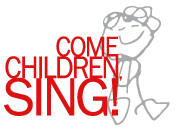Rhythm Dialogue is conversation in rhythm. Like conversation in language, it is interactive; it is improvised; it is based on mutual understanding; and it develops an ongoing “storyline.” With language, a child is immersed in the mother tongue throughout the day, and in various contexts. A baby learns to understand the language before learning to speak it, and begins speaking through babble. Parent-child games such as “Peek-a-boo” set up the model for interaction, with time for an expected response. A little child’s smile or hiding in response shows awareness of the “game”—the process of dialogue, long before a verbal response; and spontaneous rounds of “Peek-a-boo” occupy many precious moments with a little one. Similarly, Rhythm Dialogue Activities set up the model for musical interaction in rhythm, with time for an expected response, and opportunity for many precious moments of musical interaction. A smile, hiding, excitement, movement, or Rhythm Babble in response demonstrates an awareness of the “game”—participation in conversation—however limited the response. Eventually, Rhythm Babble will evolve into precise rhythmic communication, just as language babble evolves into precision in speaking.
You repeat words like “book,” “bottle,” and “ball,” over and over. Your child’s response of “BUH” could mean any of the three, but you respond to your child’s meaning based on the context, or, you provide the context—the “storyline”—“Do you want the book?” Similarly, through Rhythm Dialogue, we single out individual rhythm patterns, using them over and over in various combinations and expressions. Your child’s “BAH” could be an effort to deliver Duple meter, Triple meter, or any other. Respond to your child’s “BAH” by providing the context, the “storyline”—the meter—by chanting a familiar rhythm pattern. Follow up with another in the same meter, whatever your child’s response, maintaining the meter. Each Rhythm Dialogue Activity offers a series of patterns in one meter. Consecutive Rhythm Dialogue Activities alternate meters. Dialogue in different meters will develop a greater sense of meter, just as experience with both hot and cold develops a greater sense of temperature. Starting Rhythm Dialogue with the same rhythm pattern in any given meter sets up the meter, becoming the invitation, “Do you want to play Duple with me?,” or, “Do you want to play Triple with me?”
Rhythm Dialogue is the basis for all musical interaction. It draws out of a child his “rhythmic thinking,” and guides it to greater precision, just as dialogue facilitates language development. Rhythm Dialogue is a big step in the process of music development, a skill to be nurtured throughout life. The more rhythm patterns a child acquires in his rhythm vocabulary, the more he has to deliver in Rhythm Dialogue, and the more that little jazzman becomes skilled in musical improvisation.
|

